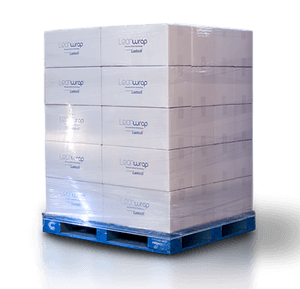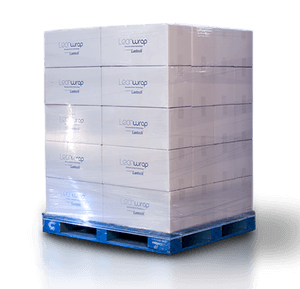From containment force to film tails, there is a lot to know if you want to achieve the efficient stretch wrapping necessary to minimize damage.
Containment Force Explained
 The first thing you should know about stretch wrapping is containment force. Containment force is the hugging pressure that holds a pallet load together. Containment force is vital for securing loads and minimizing damage. In fact, containment force is the key metric for reducing damage and ensuring you have safe-to-ship loads.
The first thing you should know about stretch wrapping is containment force. Containment force is the hugging pressure that holds a pallet load together. Containment force is vital for securing loads and minimizing damage. In fact, containment force is the key metric for reducing damage and ensuring you have safe-to-ship loads.
How do you find containment force? We find containment force by multiplying the number of revolutions of stretch film by the wrap force tightness. You should be measuring containment force on multiple points across your load (typically top, middle, and bottom).
Determining what your goal containment force should be based on actual shipping data and experience. However, here’s a link to a recommendation chart that will help you figure out the right amount of containment force for your pallet loads.
Lock Your Load to Your Pallet
Another key step in effective stretch wrapping is locking the load to the pallet. Most stretch wrappers encourage you to wrap the load all the way to the bottom of the pallet. On the surface, this might seem like an adequate method for creating a pallet to load bond, but it leaves your load vulnerable. The vulnerability of this method is exposed when the pallet is ready to move.
Most pallets are moved about with a pallet jack or forklift truck. Metal prongs, or forks, are inserted into the base of the pallet and the pallet is supported as it is moved from the underside of the load by these prongs. If, however, the stretch film is wrapped all the way to the bottom of the pallet the prongs must be inserted through the film. Once the film is breached you begin to lose containment force and risk a tear or rip that completely compromises the load.
The simplest way to avoid this problem is by creating a cable with the bottom few inches of the stretch film. At the end of the wrap cycle, the film is automatically rolled into a tight cable and driven down just below the top deck boards of the pallet. The cable is tight enough to lock the load to the pallet and is high enough to clear the forks as they pick up the load.
Don’t Forget Your Film Tails
Another place where film management comes into play is how you handle that last bit of stretch film at the end of your load. It is essential to ensure your stretch film is not left to trail along behind your load. An unsecured, or long, film tail can be caught during movement of the pallet and cause the film to be ripped or unravel.
Dragging film tails can also get tangled in downstream equipment, including conveyors, forklifts and other equipment found in factories, distribution centers and large warehouses. When a long film tail snags, it could cause the load to topple. You can prevent this by adjusting your machine settings, using automation units, film clamps, heat sealers, or wipe downs.
Want to help prevent film breaks? Here are 3 things to check.
You may be interested in these related posts:
- How tight should you wrap your pallet loads?
- Use The Force: Containment Force Is The Key to Safe Pallet Loads
- How Stretch Wrapping Reduces Risk of Damaged Pallet Goods
This post was published on June 23, 2017 and updated on November 7, 2018.
